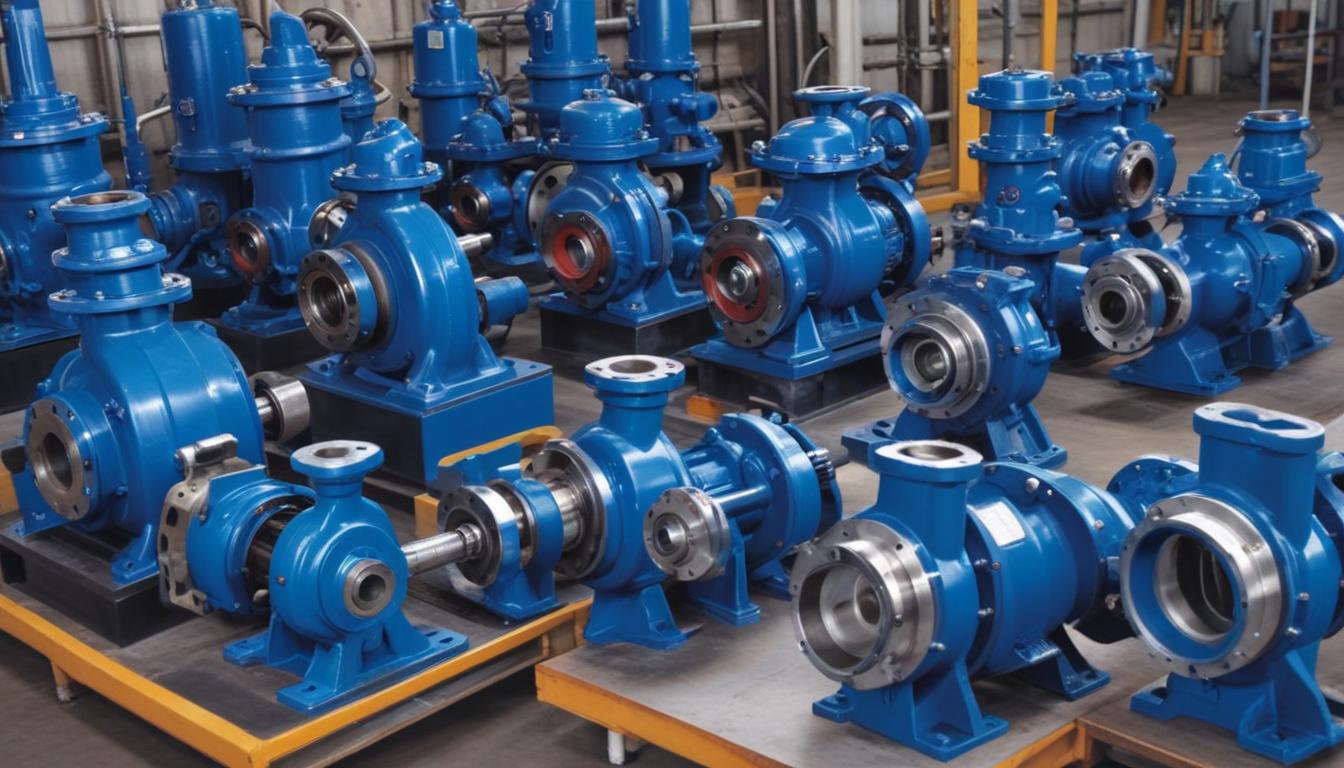sealing solutions for different pump types
Different pump types necessitate specific sealing solutions to ensure efficient and reliable operation. Selecting the appropriate pump seals involves understanding the unique characteristics and demands of each pump category. Below is an overview of various pump types and their corresponding sealing requirements:
| Pump Type | Sealing Requirements | Common Seal Types |
|---|---|---|
| Centrifugal Pumps | Handle varying pressures and high flow rates; require seals that can manage thermal expansion and prevent leakage. | Mechanical Seals, Cartridge Seals |
| Positive Displacement Pumps | Operate under high pressures with pulsating flow; need durable seals to accommodate reciprocating movements. | Packed Gland Seals, Mechanical Seals |
| Axial Flow Pumps | Designed for high flow and low pressure; seals must resist wear from continuous operation and moderate pressures. | Magnetic Seals, Soft Seals |
| Peristaltic Pumps | Utilize flexible tubing; require seals compatible with tubing materials and capable of handling repetitive compression. | Tube Seals, Flexible Rubber Seals |
| Gear Pumps | Used in lubrication systems; need seals that can withstand constant contact with oils and high-pressure environments. | O-Ring Seals, Lip Seals |
- Fluid Compatibility: The seal material must resist corrosion and degradation from the pumped fluid.
- Temperature Range: Seals should maintain integrity under the operating temperature conditions.
- Pressure Handling: Adequate sealing performance must be ensured at the system’s maximum pressure.
- Environmental Factors: Consideration of external factors such as vibration, dust, and humidity that may affect seal longevity.
By meticulously matching sealing solutions with the specific types of pumps and their operational demands, maintenance requirements are minimized, and the overall efficiency of the pumping system is enhanced.
Mechanical seals for centrifugal pumps
Mechanical seals are pivotal in ensuring the reliable and efficient operation of centrifugal pumps. These seals serve as a barrier between the pumped fluid and the external environment, preventing leaks and maintaining system integrity. A typical mechanical seal assembly consists of several key components, each playing a vital role in the sealing process.
- Sealing Faces: The primary sealing surfaces, usually made from hard, wear-resistant materials such as carbon or silicon carbide, that slide against each other to provide a leak-proof barrier.
- Spring Mechanism: Applies consistent pressure to the sealing faces, accommodating thermal expansion and vibrations while maintaining contact between the faces.
- Housing and Gaskets: Encapsulate the seal assembly, protecting it from external contaminants and ensuring stable operation within the pump environment.
- O-Rings and Gaskets: Provide secondary sealing to prevent fluid ingress and egress around the seal assembly.
Different types of mechanical seals are available to cater to the diverse requirements of centrifugal pumps:
| Type of Mechanical Seal | Description | Applications |
|---|---|---|
| Balanced Seals | Designed to handle higher pressures by balancing the fluid forces acting on the seal faces. | High-pressure centrifugal pumps, chemical processing. |
| Unbalanced Seals | Suitable for lower pressure applications with a simpler design. | Water supply systems, HVAC applications. |
| Cartridge Seals | Pre-assembled units that simplify installation and maintenance. | Industries requiring quick and efficient seal replacements. |
| Double Mechanical Seals | Utilize two sealing faces for enhanced leak protection and reliability. | Hazardous fluid handling, pharmaceutical manufacturing. |
Advantages of using mechanical seals in centrifugal pumps include:
- Leak Prevention: Provides a reliable barrier against fluid leakage, safeguarding both the system and the environment.
- Enhanced Efficiency: Reduces energy losses associated with leakage, contributing to overall pump performance.
- Durability: Engineered to withstand continuous operation, thermal fluctuations, and varying pressures.
- Reduced Maintenance: Minimizes the need for frequent seal replacements compared to traditional packing solutions.
When selecting mechanical seals for centrifugal pumps, several factors must be considered to ensure optimal performance:
- Fluid Compatibility: The seal material must resist corrosion and degradation from the pumped fluid.
- Operating Temperature: Seals should maintain integrity under the system’s temperature conditions.
- Pressure Requirements: The seal must withstand the maximum operating pressure without failure.
- Rotational Speed: Higher speeds may necessitate specialized seal designs to manage increased friction and heat.
- Installation Environment: Factors such as vibration, alignment, and ease of access for maintenance play a role in seal selection.
Proper installation and maintenance of mechanical seals are crucial for extending their lifespan and ensuring consistent performance. Key best practices include:
- Alignment: Ensuring precise alignment of the pump shaft and seal to prevent undue stress on the sealing faces.
- Cleanliness: Maintaining a contamination-free environment during installation to avoid damage to the sealing surfaces.
- Regular Inspection: Periodically checking seal components for wear, corrosion, or damage to address issues proactively.
- Appropriate Lubrication: Using compatible lubricants as recommended by the seal manufacturer to reduce friction and wear.
By selecting the appropriate mechanical seals tailored to the specific requirements of centrifugal pumps, operators can achieve enhanced reliability, reduced downtime, and improved overall system performance.
Packing solutions for positive displacement pumps
Packing solutions play a critical role in maintaining the integrity and performance of positive displacement pumps. These seals are essential for preventing leaks, managing pressures, and accommodating the dynamic movements inherent in these pump types. Effective packing solutions must be carefully selected based on the specific requirements of the pump and the characteristics of the fluid being handled.
Types of Packing Materials commonly used in positive displacement pumps include:
| Packing Material | Characteristics | Applications |
|---|---|---|
| Graphite | High-temperature resistance, low friction, excellent sealing properties. | Chemical processing, high-pressure systems. |
| PTFE (Polytetrafluoroethylene) | Chemically inert, low friction, suitable for aggressive fluids. | Pharmaceuticals, food processing, corrosive environments. |
| Aramid Fiber | High strength, good thermal stability, durable. | Oil and gas, heavy-duty industrial applications. |
| Kevlar | Exceptional strength, lightweight, resistant to wear. | High-performance systems requiring durability. |
Advantages of using packing solutions in positive displacement pumps include:
- Leak Prevention: Efficiently seals the pump shaft, minimizing fluid leakage and maintaining system pressure.
- Adaptability: Capable of handling various pump speeds and pressures, making them suitable for a wide range of applications.
- Cost-Effectiveness: Generally more affordable compared to mechanical seals, offering a budget-friendly sealing option.
- Ease of Maintenance: Simple to install and replace, allowing for straightforward maintenance procedures.
When selecting packing solutions for positive displacement pumps, several factors must be taken into account to ensure optimal performance and longevity:
- Fluid Compatibility: The packing material must be resistant to the chemical properties of the fluid being pumped to prevent degradation and ensure effective sealing.
- Operating Pressure: Higher pressure systems require packing materials with greater strength and sealing capability to maintain integrity.
- Temperature Range: The selected packing must withstand the operational temperature conditions without losing its sealing properties.
- Pump Speed: Different packing materials perform better under varying speeds; high-speed applications may benefit from materials with lower friction coefficients.
- Environmental Conditions: Exposure to factors such as vibration, corrosive elements, and abrasive particles should influence the choice of packing material.
Proper installation and maintenance of packing solutions are vital for maximizing their effectiveness and lifespan. Key best practices include:
- Correct Compression: Ensuring the packing is neither too tight nor too loose to avoid excessive wear or leakage.
- Alignment: Maintaining proper shaft alignment to prevent uneven wear and premature packing failure.
- Regular Inspection: Periodically checking the condition of the packing for signs of wear, damage, or degradation.
- Lubrication: Applying appropriate lubricants to reduce friction and minimize heat generation, thereby extending the packing’s life.
By choosing the appropriate packing solutions tailored to the specific types of positive displacement pumps and their operational demands, operators can achieve enhanced reliability, reduce downtime, and maintain the efficiency of the pumping system. Proper selection, installation, and maintenance of these packing solutions are essential components of an effective sealing strategy for positive displacement pumps.
Materials used in pump seals
 Selecting the appropriate materials for pump seals is crucial for ensuring their longevity, performance, and compatibility with the pumped media. The choice of materials directly influences the efficiency of the sealing solutions, resistance to wear, chemical compatibility, and ability to withstand various operational stresses. Understanding the distinct properties of different seal materials allows for the optimization of pump performance and the minimization of maintenance requirements.
Selecting the appropriate materials for pump seals is crucial for ensuring their longevity, performance, and compatibility with the pumped media. The choice of materials directly influences the efficiency of the sealing solutions, resistance to wear, chemical compatibility, and ability to withstand various operational stresses. Understanding the distinct properties of different seal materials allows for the optimization of pump performance and the minimization of maintenance requirements.
Common Seal Materials used in various pump types include:
| Material | Characteristics | Applications |
|---|---|---|
| Carbon | Excellent wear resistance, low friction, good thermal conductivity. | Water pumps, general industrial applications. |
| Stainless Steel | High strength, corrosion-resistant, suitable for high-pressure environments. | Chemical processing, food and beverage industries. |
| Silicon Carbide | Extremely hard, high temperature resistance, excellent chemical stability. | Petrochemical pumps, high-temperature applications. |
| PTFE (Polytetrafluoroethylene) | Chemically inert, low friction, excellent thermal stability. | Pharmaceuticals, food processing, corrosive environments. |
| Elastomers (e.g., NBR, Viton) | Flexible, good sealing properties, varying chemical resistance. | Positive displacement pumps, automotive applications. |
| Graphite | High-temperature tolerance, self-lubricating, good chemical resistance. | High-temperature centrifugal pumps, oil and gas industry. |
| Bronze | Good wear resistance, compatible with various fluids, durable. | Marine pumps, hydraulic systems. |
Factors to Consider When Selecting Seal Materials:
- Chemical Compatibility: The material must resist degradation or corrosion from the pumped fluid to maintain seal integrity.
- Temperature Range: Seals must perform reliably within the operating temperature spectrum, avoiding material softening or hardening.
- Pressure Requirements: Materials should withstand the maximum pressures encountered without failure or excessive wear.
- Wear Resistance: High durability materials are essential for applications with continuous operation or abrasive fluids.
- Flexibility: Especially important for dynamic sealing applications where movement or vibration is present.
- Cost Considerations: Balancing material performance with budget constraints to achieve cost-effective sealing solutions.
Metals such as stainless steel, carbon steel, and bronze are often used for their strength and durability. They are ideal for high-pressure applications and environments where corrosion resistance is paramount. Metals are typically employed in mechanical seals where rigid components are necessary to maintain precise sealing under varying load conditions.
Elastomers like nitrile rubber (NBR) and Viton provide flexibility and excellent sealing properties in environments where dynamic movement occurs. These materials are suitable for packing solutions in positive displacement pumps, accommodating shaft movements while maintaining an effective seal.
Ceramics such as silicon carbide offer exceptional hardness and thermal resistance, making them suitable for high-temperature and abrasive applications. Ceramic sealing faces are commonly found in centrifugal pumps operating in demanding environments like petrochemical processing.
Composites, including PTFE-based materials, combine chemical resistance with low friction properties. These materials are versatile and can be tailored to specific applications, providing a balance between durability and flexibility.
Graphite is another valuable material, particularly in high-temperature applications. Its self-lubricating properties reduce friction and wear, enhancing the lifespan of seals in aggressive environments.
Advantages of selecting appropriate materials for pump seals include:
- Enhanced Durability: Proper material selection extends the life of pump seals by resisting wear, corrosion, and thermal degradation.
- Improved Performance: Materials compatible with the pumped fluid and operating conditions ensure optimal sealing efficiency and pump operation.
- Reduced Maintenance: Durable and compatible materials minimize the frequency of seal replacements and associated downtime.
- Cost Efficiency: Investing in the right materials reduces long-term costs by preventing premature seal failures and enhancing overall system longevity.
Best Practices for selecting seal materials include:
- Thorough Fluid Analysis: Understand the chemical composition of the fluid to ensure material compatibility and prevent seal degradation.
- Environmental Assessment: Evaluate the operating environment, including temperature fluctuations, pressure variations, and exposure to contaminants.
- Performance Requirements: Determine the necessary durability, flexibility, and wear resistance based on the specific pump application.
- Consultation with Manufacturers: Engage with seal manufacturers to leverage their expertise in material performance and suitability for particular applications.
- Regular Testing: Implement testing protocols to assess material performance under actual operating conditions, allowing for adjustments as needed.
By meticulously selecting materials that align with the operational demands and fluid characteristics, effective sealing solutions can be achieved. This not only ensures the reliability and efficiency of pump systems but also contributes to the overall sustainability and cost-effectiveness of industrial processes.
Troubleshooting common seal failures
Effective troubleshooting of seal failures is essential to maintain the integrity and performance of pumping systems. Understanding the common causes and implementing appropriate solutions can significantly reduce downtime and extend the lifespan of pump seals. Below are the key aspects to consider when addressing seal failures:
Common Seal Failure Modes:
| Failure Mode | Description | Potential Indicators |
|---|---|---|
| Leakage | Escape of fluid around the seal interface. | Visible drips, reduced system pressure, fluid accumulation. |
| Wear and Tear | Gradual degradation of seal materials due to friction and operational stresses. | Increased leakage, rough shaft movement, degraded seal surfaces. |
| Corrosion | Chemical or electrochemical deterioration of seal components. | Surface pitting, discoloration, weakened structural integrity. |
| Thermal Degradation | Damage caused by excessive temperatures affecting seal materials. | Hardening or softening of seal components, brittleness, loss of elasticity. |
| Improper Installation | Incorrect fitting or alignment during seal installation. | Immediate leakage, uneven wear, increased vibration. |
| Mechanical Damage | Physical harm to the seal caused by foreign objects or misalignment. | Cracks, abrasions, or breaks in the seal materials. |
Causes of Seal Failures can be attributed to various factors, including:
- Incorrect Seal Selection: Using seals that are not compatible with the pump type, fluid properties, or operating conditions.
- Improper Installation: Misalignment, excessive compression, or contamination during installation can compromise seal integrity.
- Operating Conditions: Fluctuations in temperature, pressure, and flow rates beyond the seal’s design specifications.
- Material Incompatibility: Seal materials reacting adversely with the pumped fluid, leading to degradation.
- Vibration and Mechanical Stress: Continuous vibration or mechanical shocks can cause physical damage to seals.
- Contamination: Presence of abrasive particles or corrosive substances in the fluid can wear down seal surfaces.
Troubleshooting Steps for addressing seal failures involve a systematic approach to identify and rectify the underlying issues:
- Identify the Failure:
- Observe for visible signs of leakage or fluid loss.
- Monitor system pressure and flow rates for anomalies.
- Inspect for unusual noises or vibrations indicating mechanical issues.
- Inspect Seal Components:
- Examine the sealing surfaces for wear, cracks, or deposits.
- Check the condition of O-rings, gaskets, and other ancillary components.
- Assess the alignment and tightness of the seal assembly.
- Evaluate Operating Conditions:
- Verify that temperature and pressure are within the seal’s operating range.
- Assess the consistency of flow rates and identify any surges or fluctuations.
- Check for the presence of contaminants in the pumped fluid.
- Review Installation Procedures:
- Ensure that seals were installed according to manufacturer guidelines.
- Confirm proper alignment of the pump shaft and seal assembly.
- Verify that the installation environment was clean and free from debris.
- Replace or Repair:
- Replace worn or damaged seal components with appropriate sealing solutions.
- Rectify any alignment or installation issues identified during inspection.
- Implement corrective measures to address recurring operating condition problems.
- Implement Preventive Measures:
- Establish regular maintenance schedules for seal inspection and replacement.
- Monitor operating conditions continuously to detect and address issues promptly.
- Ensure proper training for maintenance personnel on correct installation techniques.
Preventive Measures to avoid common seal failures include:
- Proper Seal Selection: Choose pump seals that are compatible with the fluid, temperature, and pressure requirements of the application.
- Accurate Installation: Follow manufacturer guidelines meticulously to ensure correct alignment and compression of seal assemblies.
- Regular Maintenance: Conduct periodic inspections and maintenance to identify early signs of wear or damage.
- Environmental Control: Minimize exposure to contaminants, excessive vibrations, and temperature extremes that can compromise seal integrity.
- Training and Expertise: Ensure that personnel involved in installation and maintenance are adequately trained and knowledgeable about best practices.
Detection Techniques to identify seal failures early can prevent extensive damage and costly repairs:
- Visual Inspections: Regularly check for signs of leakage, wear, or corrosion around the seal area.
- Pressure Monitoring: Utilize gauges and sensors to detect abnormal pressure drops that may indicate seal leakage.
- Vibration Analysis: Monitor pump vibrations to identify misalignments or mechanical stresses affecting seal performance.
- Temperature Sensors: Track temperature changes that could signal thermal degradation of seal materials.
- Fluid Analysis: Analyze the quality and composition of the pumped fluid to detect contaminants or corrosive agents that may harm seals.
Implementing a comprehensive troubleshooting and preventive maintenance strategy ensures the reliability and longevity of pump seals. By addressing common failure modes promptly and adopting best practices in seal selection, installation, and maintenance, operators can maintain optimal pump performance and minimize operational disruptions.




